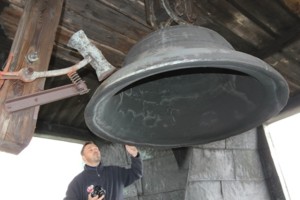Formerly known as Salomonowa (Salomon’s) or Nad Kapitularzem (Over the Chapter-House)
Construction work on the tower began in the second half of the 14th century on the order of King Kazimierz the Great. The tower was built from limestone ashlars, which were placed on earlier foundations dating from the turn of the 11th and 12th centuries. However, the construction was interrupted when the tower was 16 metres high and resumed 150 years later by Jan Salomonowicz – a canon at the Cracow Cathedral Chapter. The added part in red brick was finally completed in 1522. A fine, Baroque dome on the Clock Tower was made in 1715.The tower has two clock bells (gongs) which strike hours and quarters of an hour.
THE CATHEDRAL CLOCK
The first clock was installed in the tower in 1519. It was known as the Great Clock. Its face showed 24 hours. At the top of the tower a gong was also installed, striking hours. The clock had only one hand, so it was possible to tell the time only at an hour sharp when the clock rang. Following the clock, the day began and ended in the evening.
In 1602 the clock was replaced with a new one, whose face showed 12 hours. This type of clock was known as półzegarze (a half-clock). The day started at midnight and it took two rounds of the clock to cover day and night. In 1681 the clock was modernised and the quarter of an hour mechanism was added. Since that time an additional gong struck every 15 minutes. The hour gong struck at full hours, so it was possible to tell the exact time every 15 minutes.
In 1899 the worn-out clock mechanism was replaced by a new one, manufactured by a Prague-based company, L.Hainz. This mechanism still operates. It is actually a set of three separate mechanisms: one responsible for the clock’s operation, one for striking quarters of an hour, and one for striking hours. Each of the mechanisms has its own weight drive, which works for around 50 hours. The weights are suspended on ropes that run from the bottom to the top of the tower. The weights of the mechanisms for striking hours and quarters of an hour weigh 120 kg each, while that of the drive mechanism weighs 40 kg.
- The clock gong
- The clock mechanism
To wind the clock one must haul all the three weighs up. The clock is wound manually using a crank, every second day. The process requires great effort and takes about ten minutes. The operation of the clock is controlled by a 196-cm long pendulum connected to the escapement.
Clock faces have been installed on two walls of the Clock Tower: the western and the northern. Each is equipped with a hand that shows hours rather approximately. As it was centuries ago, the time can only be told exactly when the clock strikes hours and quarters of an hour. Like centuries ago, the time is announced by the beautiful sound of ancient gongs.



